
DFM Foods Ltd
Consumer Food
DFM Foods Ltd
Consumer Food
Stock Info
Shareholding Pattern
Price performance
Indexed Stock Performance

Pioneer of packaged snack foods in India looking to expand to the next level of growth.
DFM Foods Ltd. is an India-based company incorporated in 1993. The company is engaged in the manufacturing and marketing of processed foods, which includes snack foods. The company pioneered the entry of packaged snacks in the Indian market with the introduction of its Crax Corn Rings product.
Corn Rings and Wheat Puffs are marketed under the CRAX and NATKHAT brand names respectively. Both these products have become extremely popular snacks, especially among children. In the namkeens category, the company offers a complete range of products consisting of 13 distinct product variants that include Bhujiyas, Daals, Mixtures, and Nut-Mixes. These are sold in several pack sizes to cater to both casual/impulse consumption as well as consumption at home.
Extensive product portfolio:
DFM Foods is the pioneer of packaged snack foods in the Indian market. The company
is engaged in the business of manufacturing and selling packaged foods for more
than 3 decades. Over the years, the company has launched various brands and products.
The company markets its products under the brand names of “Crax”, “Curls”,
“Natkhat” and “Fritts”. The product portfolio comprises
of corn rings, corn puffs, wheat puffs, cheese balls, corn and potato sticks, and
traditional namkeens in 13 distinct variants.
Increased consumption of snacks and packaged foods:
We have observed a massive change in the snack foods market. Demand for packaged
foods has risen over the last several years due to urbanisation, increase in purchasing
power, growth in female working population and busier lifestyles among Indian consumers.
Packaged foods offer Indian consumers traditional snacks such as Farsan, Bhujia
and other namkeens.
New leadership and new strategy will drive future growth:
The new promoter, Advent International holds 73.91% of the company’s total
equity. Post the acquisition, the company appointed a new managing director, Mr
Lagan Shastri. Mr Shastri has worked in senior marketing positions in Hindustan
Coco Cola beverages for more than 20 years. The focus of the new leadership team
is to drive the next phase of expansion and business growth. This will be achieved
by strengthening distribution, marketing, innovation and creating a strong product
portfolio.
Splendid strategy well in place:
DFM foods focus remains on branding of the products. In order to leverage the strong
brand power of Crax, the company has launched products in “sub-segmentation
strategy”. The sub-segmentation strategy gives the benefit of umbrella advertising
as the other products are launched under the main brand “Crax”. Sub-segmentation
strategy also helps in to reduce the costs as there is no requirement of re-branding
or separate branding of the new products.
Foray into namkeens will be the subsequent growth driver:
DFM Foods has pioneered the Indian packed snacks market. The company has entered
the namkeens (Crax namkeens) segment under their flagship brand Crax. Munching on
namkeen and snacks is an ancient practice in India. DFM Foods is focusing on tapping
an opportunity by launching snacks meant for specific occasions, like to uplift
the mood, fasting and provide some fun. With consumers snacking for various reasons,
DFM foods is highlighting events or value proposition/benefits offered on the snack
pack.
Sound & improving financials:
DFM foods is expected to deliver ~26% net profit CAGR over FY20-22E. On the back
of ramp-up in sales and increasing margins from operating leverage and improved
product mix. We expect improving product mix to reflect in DFM foods financials
from FY22. Given low penetration, share gain from unorganised market, better distribution
and high operational efficiency, we believe there is sound reason to be bullish
on DFM foods.
Niche operator in snacks:
Crax has a strong positioning as a snack, especially for kids. Apart from niche
positioning, Crax is the most preferred snack and less expensive than most other
snacks. To maintain its leadership position, Crax has remained unique through its
strategy of giving a free gift (toy) in each pack.
Outlook & valuation
DFM Foods has strong brand presence across the country. The company is well known
for its Crax brand which dominates the market (65% market share) and hearts of children.
We believe Indians (especially children) have an emotional connect with eating snacks
and this will continue to drive the future growth of the company. We expect the
recent capacity addition of 5,000 MTPA will enhance revenues and profitability for
the company. Further, the new promoter and management will drive high operational
efficiency, which, in turn, will increase profitability. We initiate “Buy”
on DFM Foods Limited on the back of strong brand presence, new product launches,
continuous innovation in existing products, and rising customer reach. At CMP of
Rs. 339, the company trades at PE of 55x/ 36x our FY21E/ FY22E EPS estimates.
Consolidated Financial Statements
| (In Rs Cr) | Sales | EBITDA | EBITDA % | PAT | EPS | ROE % | EV/EBITDA | P/BV |
|---|---|---|---|---|---|---|---|---|
| FY18 | 425.00 | 51.00 | 12.00% | 23.00 | 5.00 | 24.90% | 28.60 | 13.80 |
| FY19 | 484.00 | 63.00 | 13.10% | 33.00 | 7.00 | 28.30% | 17.20 | 8.40 |
| FY20 | 508.00 | 42.00 | 8.20% | 24.00 | 5.00 | 17.80% | 21.00 | 6.00 |
| FY21E | 549.00 | 59.00 | 10.80% | 32.00 | 6.00 | 20.20% | 29.90 | 10.40 |
| FY22E | 631.00 | 83.00 | 13.10% | 49.00 | 10.00 | 25.90% | 21.00 | 8.60 |
Investment Rationale
Extensive product portfolio:
DFM Foods is the pioneer of packaged snack foods in the Indian market. The company
is engaged in the business of manufacturing and selling packaged foods for more
than 3 decades. Over the years, the company has launched various brands and products.
The company markets its products under the brand names of “Crax”, “Curls”,
“Natkhat” and “Fritts”. The product portfolio comprises
of corn rings, corn puffs, wheat puffs, cheese balls, corn and potato sticks, and
traditional namkeens in 13 distinct variants.
Product portfolio:
Crax:
Launched in 1984, this was the first product of its kind to hit Indian retail shelves
and it was instantly successful. In no time, it became quite the favourite especially
among children. Its unique ring shape has captured the hearts and fingers of children.
Crax Curls:
This latest innovation in the Crax portfolio has a unique, melt-in-mouth texture
and is available in 3 lip smacking flavours - Chatpata Masala, Tomato Treat and
Spicy Delight. With a large pack-fill, this product offers great value to the consumer
at Rs. 5.
Crax namkeens:
A range of ethnic snacks made from the finest ingredients, Crax Namkeens comprise
of a wide range of Bhujias, Mixtures and Nut-Mixes. A total of 12 different product
variants are available in pack sizes of Rs. 5, Rs. 10 and Rs. 20.
Crax pasta crunch:
Pasta crunch is a mouth-watering crunchy snack that comes in pasta shape. It blends
the best of Chinese and Indian spices in its "Chinese Tadka" flavour and
is priced at Rs. 5 per pack.
Natkhat:
Natkhat is light and crunchy delicious wheat puffs with a lower fat content. It
is available in classic and masala flavours. It comes in two package sizes priced
at Rs. 2 and Rs. 5.
Exhibit No 1: DFM Foods’ product portfolio
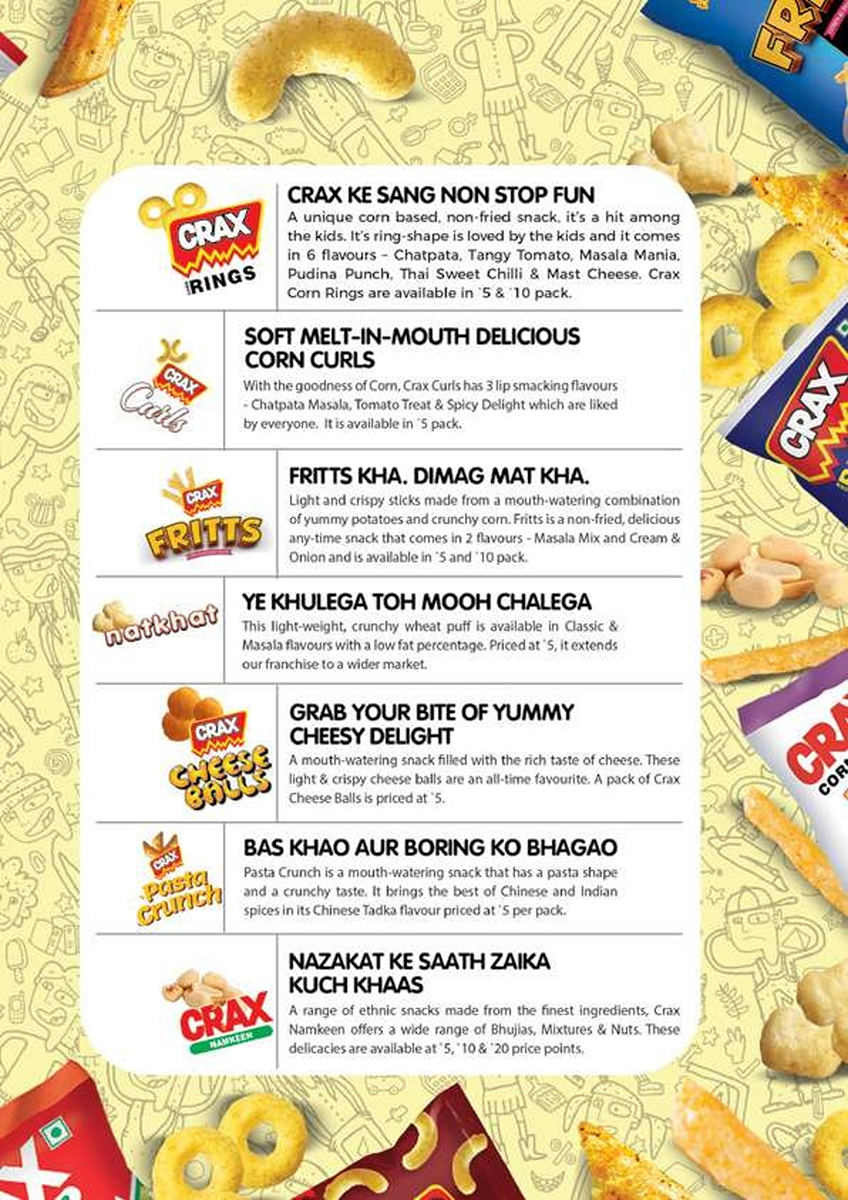
Source: Company, StockAxis Research
Increase in consumption of snacks and packaged foods:
We have observed a massive change in the snack foods market. Demand for packaged
foods has increased over the last several years due to urbanisation, increase in
purchasing power, growth in female working population and busier lifestyles among
Indian consumers. Packaged foods offer Indian consumers traditional snacks such
as farsans, bhujia and other namkeens. We observe a shift from loose packaging namkeens
to standard and packaged namkeens (such as Crax namkeens, Haldiram, Bikaji and Balaji).
Packaged snacks and namkeens have a deeper impact on customers as they are easily
available in local stores, hygienically processed and packed, and are more popular
due to brand awareness and celebrity endorsements. Customers know that packaged
foods use the best ingredients and are always fresh. Currently, the organised players
have market share of around 39% as compared to 20% in 2015. Organised players’
market share is expected to grow in double digit.
Exhibit No 2: Industry Trends (In %)
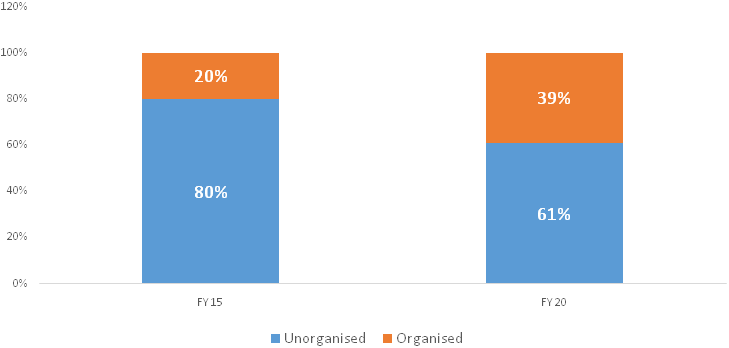
Source: Company, StockAxis Research
New management and new strategy will drive future growth: In
November 2019, buyout firm Advent International acquired a little more than 13 million
equity shares at Rs 249.50 per share, representing 26% of the expanded voting share
capital of the company. Prior to that, in September 2019, Advent International entered
into agreements to acquire (i) promoter shares constituting 38.27% of the paid up
share capital and 38.14% of the expanded voting share capital; (ii) WestBridge’s
shares constituting 24.87% of the paid up share capital and 24.79% of the expanded
voting share capital; and (iii) other shareholders’ shares constituting 4.99%
of the paid up share capital and 4.97% of the expanded voting share capital. This
indicates increased interest and confidence of the acquirer in the performance of
the company. Post these acquisitions, Advent International holds 73.91% of the company’s
total equity. Post the acquisition, a new managing director, Mr Lagan Shastri has
been appointed. Mr Shastri has worked in senior marketing positions in Hindustan
Coco Cola beverages for more than 20 years. The focus of the new leadership team
is to drive the next phase of expansion and business growth. This will be achieved
by strengthening, distribution, marketing, innovation and creating a strong product
portfolio.
Splendid strategy well in place:
DFM foods focus remains on branding of the products. In order to leverage the strong
brand power of Crax, the company has launched products in “sub-segmentation
strategy”. The sub-segmentation strategy gives the benefit of umbrella advertising
as the other products are launched under the main brand “Crax”. Sub-segmentation
strategy also helps in to reduce the costs as there is no requirement of re-branding
or separate branding of the new products. Over the years the company has launched
4 different products under the main brand Crax.
Exhibit No 3: Brand Structure

Source: Company, Stockaxis Research
Foray into namkeens will be the subsequent growth driver:
DFM Foods has pioneered the Indian packed snacks market. The company has entered
the namkeens (Crax namkeens) segment under their flagship brand Crax. Munching on
namkeen and snacks is an ancient practice in India. DFM Foods is focusing on tapping
an opportunity by launching snacks meant for specific occasions, like to uplift
the mood, fasting and provide some fun. With consumers snacking for various reasons,
DFM foods is highlighting events or value proposition/benefits offered on the snack
pack. We believe the company can replicate the success of Crax corn rings in its
new products too. We expect Crax namkeens to grow in double digit in upcoming years.
Sound & improving financials:
DFM foods is expected to deliver ~26% net profit CAGR over FY20-22E. On the back
of ramp-up in sales and increasing margins from operating leverage and improved
product mix. We expect improving product mix to reflect in DFM foods financials
from FY22. Given low penetration, share gain from unorganised market, better distribution
and high operational efficiency, we believe there is sound reason to be bullish
on DFM foods. We expect DFM foods to increase sales at ~7% CAGR, EBITDA at ~26%
CAGR and PAT at ~26% CAGR over FY20-22E.
Exhibit No 4: Improving margin trend
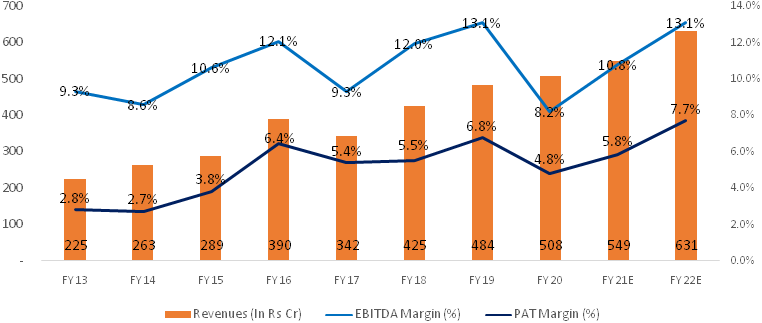
Source: Company Stockaxis Research
Niche operator in snacks:
Crax has strong positioning as a snack, especially for kids. Apart from niche positioning,
Crax is the most preferred snack and less expensive than most other snacks. To maintain
its leadership position, Crax has remained unique by its strategy of giving a free
gift (toy) in each pack.
Exhibit No 5: Strategy of free toy in each pack
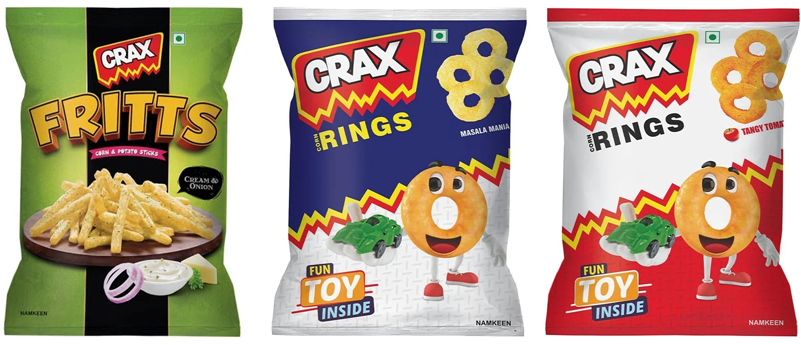
Source: Company, StockAxis Research
Financials
Revenue is expected to grow @~7% CAGR over FY20-FY22E
We expect DFM Foods’ revenue to grow at 7% CAGR over FY20-FY22E to Rs. 631
crores by FY22 on the back of new capacity addition of 5,000 MTPA and entry in new
geographies. The company has grown its revenues by 6% CAGR during FY18-FY20. We
expect revenue to grow in single digit for FY21 by 8% yoy to Rs. 549 crores, mainly
due to impact of Covid-19 in Q1 FY21. Due to the pandemic, the company faced logistics
challenges in Q1 FY21, and due to unavailability of branded products, consumers
tended to choose un-branded products.
Exhibit no 6: Revenue trends (In Rs Cr)
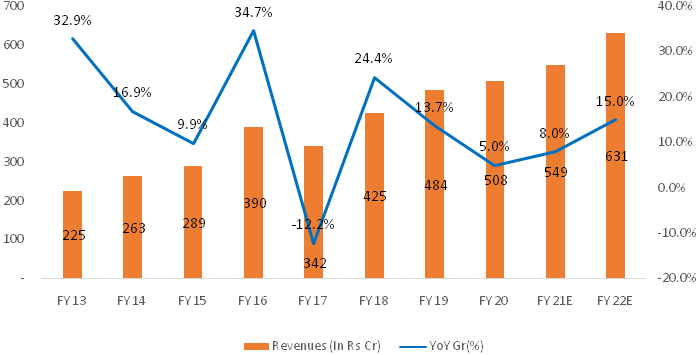
Source: Ace equity, StockAxis Research
EBITDA margins are expected to expand by ~490 bps over FY20-FY22E
We expect EBITDA to grow at CAGR of ~26% over FY20-FY22E, and EBITDA margins to
expand by ~490 bps over FY20-FY23E due to higher capacity utilisation and lower
operating costs. Given strong sales and high operating leverage and improved product
mix will aid margin expansion in future. We expect EBITDA margins to expand by ~260
bps yoy to 10.8% in FY21E.
Exhibit No 7: EBITDA and EBITDA margin trend (In Rs Cr)
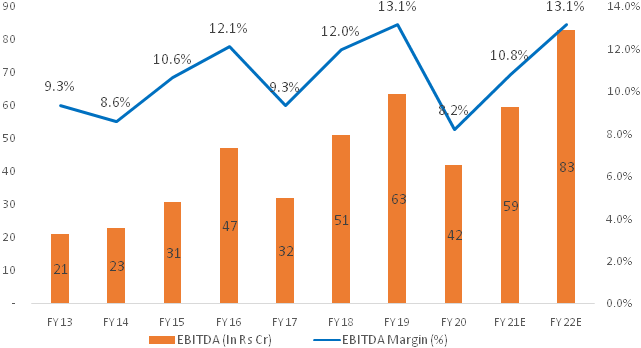
Source: Ace equity, StockAxis Research
Net profit is expected to grow at ~26% CAGR
We expect net profit to grow @ ~26% CAGR over FY20-22E on the back of high operational
efficiency and lower tax rates. The company grew its net profit by 2% CAGR during
FY18-FY20. In the past company’s profits remained very inconsistent due to
inferior product mix, volatile RM costs and higher ad spends. We believe with the
help of new management the company will enjoy higher operating leverage. We see
tapering advertisement costs and sales promotions through cartoon characters and
toys is likely to continue. We expect push-advertising costs are unlikely to grow
in-line with sales.
Exhibit No 8: Net profit trend (In Rs Cr)
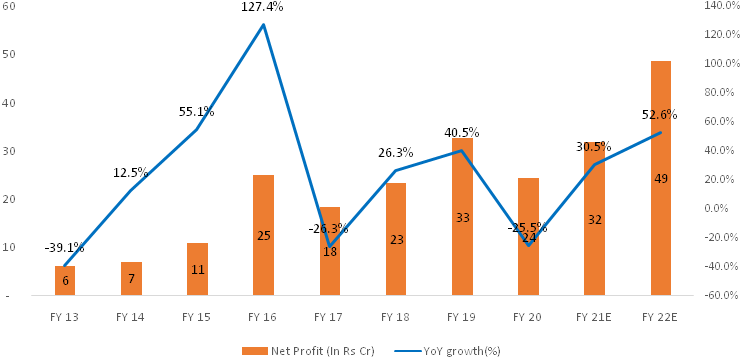
Source: Ace equity, StockAxis Research
Industry
The Indian snack food industry is a promising and growing arm of the Fast-Moving Consumer Goods (FMCG) category. The snacks industry has been on the rise for several years, but the last few years have been marked by notable growth. Today, consumers want a variety of easy-to-carry, price-effective snacks that do not compromise on taste and nutrition. The industry has seen transition from freshly made snacks to packaged, instant and ready-to-cook snacking food items.
The Indian traditional and namkeen organised snack food market is estimated to be around Rs. ~49,850 crores for the year FY 2020-21. The market is divided into 4 segments - namkeen and traditional snacks, extruded snacks, chips and others. Around 39% of the market is captured by organized players; the organized market is expected to grow by about 15% per annum, whereas the entire market is expected to grow by 7-8% per annum. Today, around 1,000 snack items are sold in India spanning various tastes, forms, textures, aromas, bases, sizes, shapes and fillings. Besides, some 300 types of savouries are sold in our country today. The extruded snacks market is influenced by the growth of retail food industry and the extruded snack market is projected to grow at a CAGR of 15% from 2019-2024.
Exhibit No 9: Organised market (In Rs Cr)
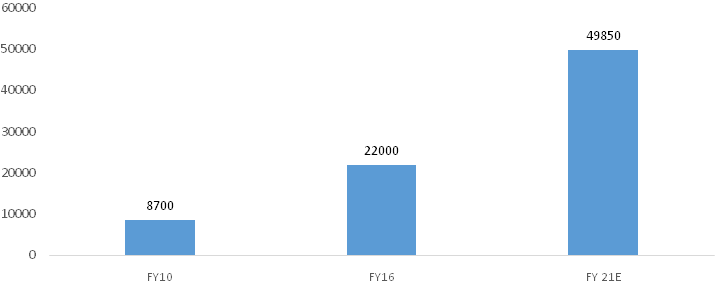
Source: Company, McKinsey, Stockaxis Research
Growth Drivers of the Industry
Increasing per capita Income:
Increasing per capita incomes of people living in urban, semi-urban and rural regions
of the country is one of the major factors driving consumption of the snacks industry.
The snacks market is also expected to be positively influenced by anticipated growth
in the country’s retail food market in the coming years.
Growing Young Population:
A growing young population with a strong preference for packaged snack foods is
driving growth for this market. Children are a major target segment of the snacks
market which include chips and extruded snack segment.
Smaller and affordable pack sizes:
With growing urbanisation, the industry has introduced smaller and affordable pack
sizes at competitive pricing, which has contributed to the growth of the snacks
market in India.
Evolving consumer habits:
Consumers demand a range of natural products that deliver health benefits in convenient
formats. They are more attuned to healthy eating habits with focus on ingredients
used to prepare the food. The industry is responding to this demand by focusing
efforts on developing snacks that contain healthy ingredients while satisfying cravings.
This growing innovation has led to rapid shifts in the category and brand portfolios.
Source: McKinsey, Company, IBEF, Stockaxis research.
Overview of the Indian packed foods
Indian packed snack food industry is mainly divided into three segments:
- Namkeen & traditional snacks category contributes 41% of the total organised market and is pegged at `7,848cr, dominated by Haldirams (48% market share). It is expected to grow at a CAGR of 18% over FY16-21E to `17,782cr category.
- Extruded snacks are the second largest contributors in the industry at 32%, dominated by PepsiCo. It is expected to grow at a CAGR of 15% over FY16-21E to `13,988cr category.
- Chips contribute 25% to the overall organised market, dominated by PepsiCo’s Lays. It is expected to grow at 10% CAGR over FY16-21E to `10,619cr market.
Exhibit no 10: Diversification of packed snacks as on FY20 (In %)
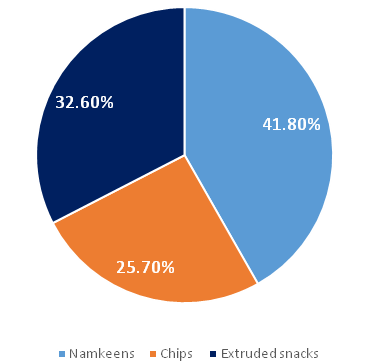
Source: Mckinsey, Stockaxis Research
Exhibit no 11: Region wise revenues for packed foods as on FY20 (In %)
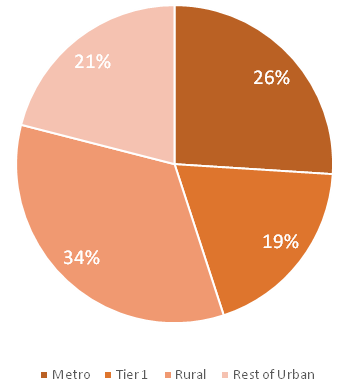
Source: Mckinsey, Stockaxis Research
Key players in domestic organised snacks market:
DFM Foods:
DFM was one of the first few players to aggressively enter the extruded snacks market
and it was the pioneer in bundling toys with snacks and targeting kids to drive
growth. It sells its products under the CRAX brand. We believe, on account
of new promoters’ the company can expand its distribution reach and launch
new products. We expect high corporate governance and operational efficiency kicking
in which will aid operating margin expansion.
PepsiCo:
The company employed multi-pronged strategy to grow the India business. It entered
the Indian market with a homogenous product chips and followed it with another homogenous
category of extruded snacks (by launching Kurkure); both categories and
products have national acceptance. Despite having strong R&D capabilities, parent’s
support and deep pockets, it has not being able to crack the Indian namkeen market
owing to high level of regional preference and taste.
Haldiram (North + West):
Haldiram as a brand rules India’s snacks market with an overall market share
of 20%. This is driven by strong understanding of regional taste and preferences.
Long-term presence through local operations in various parts of the country has
enabled Haldiram to understand local tastes, develop products to cater to these
and thereby establish strong brand equity. However, despite strong regional connect,
the company has not succeeded at the national level in categories like chips and
extruded snacks.
ITC (Bingo+ No rulz):
ITC relied on extruded and chips/nachos products which have national and followed
it up with national level media campaigns to establish national brand. Its existing
distribution strength, riding other FMCG businesses, also helped it expand its reach
nationally. However, despite being a player with deep pockets, innovation in the
category has been weak and the company has been largely a follower in the space.
Moreover, it has failed to enter the regional namkeen market, which entails better
margins and is a high growing category.
Balaji Wafers:
The company started as a chips player, with strong value-for-money proposition in
Gujarat and Rajasthan markets. After attaining critical mass in the segment, it
ventured in to the namkeen category. Despite improving its product mix, the company
has not been able to expand itself beyond western India. This is largely due to
its strategy of directly dealing with distributors /running own logistics to cover
a distance of 100-200 km of each of its factories. While till date this strategy
has worked for the company both in terms of growth as well as margins, beyond a
time we believe in order to grow and penetrate it will face challenges as it spreads
its wings beyond its home market.
Swot Analysis of DFM Foods Limited
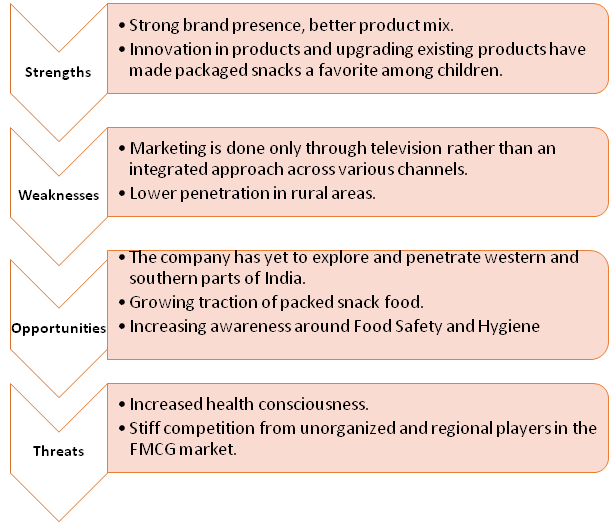
Peer Comparison:
| Company | EBITDA Margin | PAT margin | RoCE | RoE | Debt to Equity(x) | PE Ratio (x) | EV/EBITDA(x) |
|---|---|---|---|---|---|---|---|
| DFM | 8.20% | 4.80% | 15.00% | 17.80% | 0.60 | 69.50 | 36.90 |
| Prataap Snacks | 6.79% | 2.40% | 7.78% | 5.37% | 0.01 | 45.00 | 17.10 |
Risks & Concerns
Raw material risk: Lower agricultural production and any adverse effects on commodities can cause volatility in the prices of raw materials (maize and oil) which may result in increased cost of materials for the company.
Rise in competition: The company faces intense competition from recognised organised and unorganised players in the market. Rising competition can result in reduced margins and may affect profitability.
Revenue concentration risk: Concentration on particular geographic areas for revenue generation may result in limited growth.
Outlook & valuation
DFM Foods has strong brand presence across the country. The company is well known for its Crax brand which dominates the market (65% market share) and hearts of children. We believe Indians (especially children) have an emotional connect with eating snacks and this will continue to drive the future growth of the company. We expect the recent capacity addition of 5,000 MTPA will enhance revenues and profitability for the company. Further, the new promoter and management will drive high operational efficiency, which, in turn, will increase profitability. We initiate “Buy” on DFM Foods Limited on the back of strong brand presence, new product launches, continuous innovation in existing products, and rising customer reach. At CMP of Rs. 339, the company trades at PE of 55x/ 36x our FY21E/ FY22E EPS estimates.
Financial Statement
Profit & Loss statement
| Year End March (In Rs Cr) | 2018 | 2019 | 2020 | 2021E | 2022E |
|---|---|---|---|---|---|
| Net Sales | 425.00 | 484.00 | 508.00 | 549.00 | 631.00 |
| % Growth | 24.40% | 13.70% | 5.00% | 8.00% | 15.00% |
| Expenditure | 374.00 | 420.00 | 466.00 | 489.00 | 548.00 |
| Material Cost | 256.00 | 284.00 | 305.00 | 329.00 | 369.00 |
| Employee Cost | 42.00 | 46.00 | 55.00 | 52.00 | 60.00 |
| Other expenses | 77.00 | 90.00 | 106.00 | 108.00 | 119.00 |
| EBITDA | 51.00 | 63.00 | 42.00 | 59.00 | 83.00 |
| EBITDA Margin | 12.00% | 13.10% | 8.20% | 10.80% | 13.10% |
| Growth (%) | 59.70% | 24.80% | -34.30% | 42.10% | 39.50% |
| Depreciation & Amortization | 10.00 | 11.00 | 11.00 | 14.00 | 15.00 |
| EBIT | 40.86 | 52.94 | 30.35 | 45.54 | 67.72 |
| Other Income | 4.00 | 7.00 | 7.00 | 7.00 | 7.00 |
| Interest & Finance Charges | 10.00 | 11.00 | 10.00 | 10.00 | 9.00 |
| Share of Associates | - | - | - | - | - |
| Exceptional Items | - | -2.00 | - | - | - |
| Profit Before Tax | 35.00 | 47.00 | 27.00 | 43.00 | 65.00 |
| Tax Expense | 12.00 | 15.00 | 3.00 | 11.00 | 16.00 |
| Net Profit | 23.00 | 33.00 | 24.00 | 32.00 | 49.00 |
| Net Profit Margin | 5.50% | 6.80% | 4.80% | 5.80% | 7.70% |
| Growth | 26.30% | 40.50% | -25.50% | 30.50% | 52.60% |
| Adjusted EPS | 5.00 | 7.00 | 5.00 | 6.00 | 10.00 |
Balance Sheet
| Year End March (In Rs Cr) | 2018 | 2019 | 2020 | 2021E | 2022E |
|---|---|---|---|---|---|
| Share Capital | 10.00 | 10.00 | 10.00 | 10.00 | 10.00 |
| Total Reserves | 91.00 | 118.00 | 133.00 | 157.00 | 194.00 |
| Share Warrants & Outstandings | 1.00 | 1.00 | 3.00 | 3.00 | 3.00 |
| Shareholders' Funds | 102.00 | 129.00 | 145.00 | 170.00 | 207.00 |
| Minority Interest | 0.00 | 0.00 | 0.00 | 0.00 | 0.00 |
| Total Non-current Liabilities | 103.00 | 110.00 | 129.00 | 135.00 | 133.00 |
| Deferred Tax Assets / Liabilities | 16.00 | 20.00 | 15.00 | 15.00 | 15.00 |
| Long Term Burrowing | 81.00 | 83.00 | 78.00 | 84.00 | 82.00 |
| Other Long Term Liabilities | 4.00 | 4.00 | 31.00 | 31.00 | 31.00 |
| Long Term Provisions | 3.00 | 3.00 | 4.00 | 4.00 | 4.00 |
| Total Current Liabilities | 84.00 | 103.00 | 132.00 | 116.00 | 118.00 |
| Trade Payables | 35.00 | 43.00 | 55.00 | 46.00 | 48.00 |
| Other Current Liabilities | 22.00 | 23.00 | 29.00 | 21.00 | 21.00 |
| Short Term Borrowings | 6.00 | 4.00 | 5.00 | 5.00 | 5.00 |
| Short Term Provisions | 22.00 | 33.00 | 44.00 | 44.00 | 44.00 |
| Total Equity & Liabilities | 290.00 | 343.00 | 406.00 | 420.00 | 457.00 |
| ASSETS | |||||
| Total Non-Current Assets | 190.00 | 194.00 | 244.00 | 263.00 | 263.00 |
| Net Block | 155.00 | 166.00 | 218.00 | 237.00 | 237.00 |
| Capital Work in Progress | 4.00 | 6.00 | 13.00 | 13.00 | 13.00 |
| Long Term Loans & Advances | 3.00 | 2.00 | 3.00 | 3.00 | 3.00 |
| Other Non Current Assets | 28.00 | 21.00 | 10.00 | 10.00 | 10.00 |
| Total Current Assets | 101.00 | 148.00 | 163.00 | 157.00 | 194.00 |
| Currents Investments | 52.00 | 55.00 | 58.00 | 58.00 | 58.00 |
| Inventories | 24.00 | 22.00 | 24.00 | 22.00 | 24.00 |
| Sundry Debtors | 0.00 | - | 0.00 | - | - |
| Cash and Bank | 2.00 | 37.00 | 34.00 | 31.00 | 65.00 |
| Other Current Assets | 1.00 | 2.00 | 4.00 | 4.00 | 4.00 |
| Short Term Loans and Advances | 21.00 | 32.00 | 43.00 | 43.00 | 43.00 |
| Total Assets | 290.00 | 343.00 | 406.00 | 420.00 | 457.00 |
Cash Flow Statement
| Year End March (In Rs Cr) | 2018 | 2019 | 2020 | 2021E | 2022E |
|---|---|---|---|---|---|
| Profit After Tax | 23.00 | 33.00 | 24.00 | 32.00 | 49.00 |
| Depreciation | 10.00 | 11.00 | 11.00 | 14.00 | 15.00 |
| Changes In working Capital | -11.00 | 11.00 | 10.00 | -6.00 | 0.00 |
| Cash Flow after changes in Working Capital | 22.00 | 54.00 | 45.00 | 39.00 | 63.00 |
| Other Items | 12.00 | 9.00 | -3.00 | - | - |
| Cash From Operating Activities | 34.00 | 63.00 | 43.00 | 39.00 | 63.00 |
| Cash Flow from Investing Activities | -13.00 | -48.00 | -14.00 | -33.00 | -15.00 |
| Purchase of Fixed Assets | -13.00 | -23.00 | -24.00 | -33.00 | -15.00 |
| Sale of Fixed Assets | 1.00 | 0.00 | 4.00 | - | - |
| Others | 0.00 | -25.00 | 6.00 | - | - |
| Free Cash Flows | 21.00 | 40.00 | 18.00 | 6.00 | 48.00 |
| Cash Flow from Financing Activities | -21.00 | -13.00 | -21.00 | -10.00 | -14.00 |
| Proceeds from Long Term Borrowings | 14.00 | 15.00 | 1.00 | ||
| Repayment of Long Term Borrowings | -14.00 | -14.00 | -5.00 | ||
| Short Term Loans | -5.00 | -2.00 | 1.00 | ||
| Increase / (Decrease) in Loan Funds | -5.00 | 0.00 | -3.00 | -2.00 | -2.00 |
| Equity Dividend Paid | -5.00 | -5.00 | -6.00 | -6.00 | -10.00 |
| Income tax on dividend paid | -1.00 | -1.00 | -1.00 | -1.00 | -2.00 |
| Others | -11.00 | -7.00 | -10.00 | - | - |
| Net Cash Inflow / Outflow | 0.00 | 2.00 | 8.00 | -3.00 | 34.00 |
| Opening Cash & Cash Equivalents | 1.00 | 1.00 | 4.00 | 11.00 | 8.00 |
| Closing Cash & Cash Equivalent | 1.00 | 4.00 | 11.00 | 8.00 | 42.00 |
Key Ratios
| Year End March | 2018 | 2019 | 2020 | 2021E | 2022E |
|---|---|---|---|---|---|
| Per Share | |||||
| Basic EPS | 4.60 | 6.50 | 4.80 | 6.20 | 9.50 |
| Diluted EPS | 4.60 | 6.50 | 4.80 | 6.20 | 9.50 |
| Book value (Rs/share) | 20.30 | 25.60 | 28.50 | 33.30 | 40.50 |
| DPS | 1.00 | 1.30 | 0.00 | 1.20 | 1.90 |
| ROE (%) | 24.90% | 28.30% | 17.80% | 20.20% | 25.90% |
| ROCE (%) Post Tax | 16.70% | 20.60% | 15.00% | 16.10% | 20.20% |
| Receivable Days | 0.00 | 0.00 | 0.00 | 0.00 | 0.00 |
| Inventory Days | 18.00 | 17.00 | 16.00 | 15.00 | 13.00 |
| Payable Days | 32.00 | 29.00 | 35.00 | 34.00 | 27.00 |
| Working Capital (days) | -14.00 | -12.00 | -19.00 | -18.00 | -14.00 |
| Liquidity Ratio | |||||
| Total debt/Equity | 0.91 | 0.72 | 0.63 | 0.52 | 0.42 |
| Net debt/Equity | 0.38 | 0.01 | 0.00 | 0.00 | 0.00 |
| EV/EBITDA | 28.60 | 17.20 | 21.00 | 29.90 | 21.00 |
| P/BV | 13.80 | 8.40 | 6.00 | 10.40 | 8.60 |
| P/Sales | 3.30 | 2.30 | 1.70 | 3.20 | 2.80 |
| Operating Cash Flow/PAT | 1.50 | 1.90 | 1.70 | 1.20 | 1.30 |